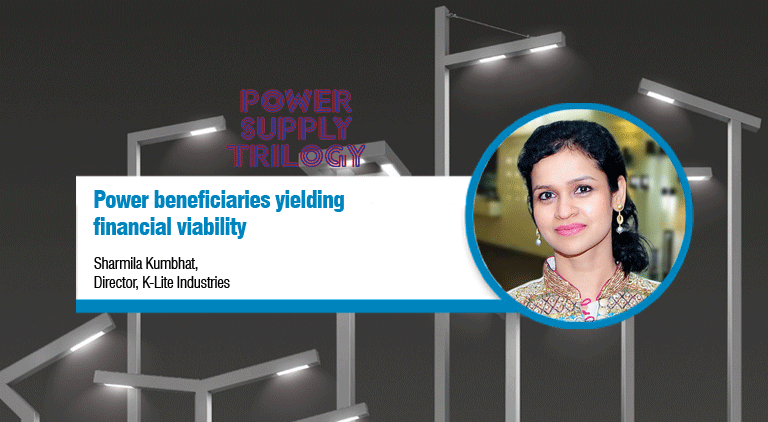Power beneficiaries yielding financial viability
By EPR Magazine Editorial November 18, 2019 10:38 am IST
By EPR Magazine Editorial November 18, 2019 10:38 am IST

Government giveaways like free power and other favours have crippled the economic stability, and ability of the distribution network to pay and purchase power.
Discussing the recurring issues of government giveaways that have been affecting the distribution sector’s economic stability, Sharmila Kumbhat, Director, K-Lite Industries says that unless there an internal acceptance and a will to reframe working norms it’s difficult to reconcile the debt concerns.
Moving away from generation and focusing on supply. Your take?
Focusing on supply side of the electricity distribution, is no doubt a most welcome step by the electric utilities to ensure quality of supply, reduction of theft of energy, extending electricity to all the places, energy saving, and above all making the electric utility a viable and a sustainable entity. Having allowed so many concessions and nonviable tariff including free supply based on political considerations, is a tremendous task to rectify the mistakes. Even after establishing the regulatory commissions, all the State Governments are still unable to solve the problems. We know the problem and the solution, but the decision makers are not prepared to commit themselves out of fear of losing support.
In general, industrial and commercial consumer, subsidised domestic and agricultural consumers. Government giveaways such as free electricity for farmers, created favoritism to curry political favor, have depleted the cash reserves of state-run electricity-distribution system and led to huge debts in thousand of crores. This has crippled economic stability of the distribution network, and its ability to pay to purchase power in the absence of subsidies from state governments. Shouldn’t we call this situation bankruptcy of the distribution utility?
The generation portion seems to be a little rosy with considerable non-conventional power generation and private player’s participation. As of 30th June, 2019, India has an installed renewable energy capacity of 80.47 GW. There are plans to double wind power generation capacity to 60 GW, by 2022. The government plans to double the share of installed electricity generation capacity of renewable energy to 40 per cent till 2030. But who has to pay for their generation? How will they survive and add to their capacity, if the beneficiary is not financially viable and is en-route to bankruptcy?
What policy or tariff changes are you expecting to come to improve efficient energy distribution?
What kind of infrastructure should be in place for an efficient supply?By replacing conventional street lighting with automated LED alternatives, how big the difference and efficient would be?
Conversion of conventional street lights into LED alternative is definitely happening around the whole country and has proved to be a major energy saving feature for all local administration agencies. Distribution of free and subsidised LED bulbs, by government and social organisations has created an consciousness among the public, as to the quantum of reduction in energy bills with the usage of LED bulbs and everybody is conscious of their choice to go in for LED lights. In fact, the whole lighting market including the Indian manufacturing sector now deals only with LED fixtures.
India was supposed to become the world’s first country to use LEDs for all lighting needs by 2019. Where are we on that?
Yes, urban elite have already opted to use LED and the rural areas are also educated through free and subsidised distribution of LED bulbs and the availability of LED bulbs at competitive cost due to the scaled up demand, are sufficient proof that we will now be leading the application of LED for our lighting needs.
Sharmila Kumbhat,Director,K-Lite Industries
We use cookies to personalize your experience. By continuing to visit this website you agree to our Terms & Conditions, Privacy Policy and Cookie Policy.